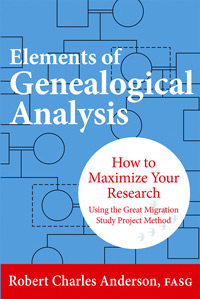 The accuracy, thus the validity, of any family tree is only as good as the records and sources by which each ancestor on the tree is identified. Many genealogy enthusiasts have used their professional experience to establish methodologies for resolving genealogical conundrums. Elements of Genealogical Analysis, by Robert Charles Anderson, is a recently published book that provides a unique perspective on how to solve genealogical problems.
The accuracy, thus the validity, of any family tree is only as good as the records and sources by which each ancestor on the tree is identified. Many genealogy enthusiasts have used their professional experience to establish methodologies for resolving genealogical conundrums. Elements of Genealogical Analysis, by Robert Charles Anderson, is a recently published book that provides a unique perspective on how to solve genealogical problems.
Anderson has a diverse background in areas such as radio electronics and bio-chemistry. Over the years he developed a methodology to his genealogical research based on his unique perspective taken from his professional life. He learned to put together clues from radio signals to create a pictures of complete radio networks. As a bio chemist he learned that from examining the way enzymes break down protein structures he could see how different enzymes produced different collections of protein fragments. “By studying these fragments, and the ways in which they overlapped, one was able to reconstruct the full sequence of the protein.” These skills led him to think of genealogical research in terms of collecting fragmentary data, comparing bits of information, and eventually creating a complete picture. Eventually these skills and ideas led to a complete system of solving genealogical problems.
Elements of Genealogical Analysis is the manual to Anderson’s ideas and method, as he explains “the purpose of this book is to elaborate a systematic methodology for doing genealogy. Specifically, this book will look at how to solve a genealogical problem.” This book establishes a methodology, a series of steps, one can use to resolve the main issue the author puts before us when he states, “each genealogical problem really comes down to one basic question: does a given record or piece of evidence refer to the person I am researching?”
The answer, as put forth by Anderson, and detailed in a comprehensive methodology can be outlined, or “formulated,” as two “compact, fundamental rules:
First Fundamental Rule: All statements must be based only on accurately reported, carefully documented, and exhaustively analyzed records.
Second Fundamental Rule: You must have a sound, explicit reason for saying that any two individual records refer to the same person.”
The application of these two rules is outlined in the book in two parts. First, are the analytic tools one needs to apply to their research. Second, is the series of seps used to go from question to answer.
Part One looks at the tools needed for source analysis, record analysis, and linkage analysis. Part Two, breaks problem solving into five steps: problem selection, problem analysis, data collection, synthesis, and problem resolution. Each of the three tools and five steps are given their own chapter spread over 168 pages.
Improve upon your own research skills by applying the techniques taught by Robert Anderson in Elements of Genealogical Analysis, available from Family Roots Publishing.
Robert Anderson was the Winner of the National Genealogical Society’s 2015 award for Excellence: Genealogical Methods and Source for this book, Elements of Genealogical Analysis.
About the Author:
“Robert Charles Anderson is the director of the Great Migration Study Project at NEHGS. He was educated as a bio-chemist and served in the United States Army in electronics intelligence. In 1972 he discovered his early New England ancestry and thereafter devoted his time and energies to genealogical research. In 1983 he received a master’s degree in colonial American history from the University of Massachusetts at Amherst, and he was elected a Fellow of the American Society of Genealogists in 1978. Anderson was coeditor of ‘The American Genealogist’ from 1993 to 2012, and he has been an editorial consultant to ‘The New England Historical and Genealogical Register’ since 1989.”
Contents
Preface
Acknowledgments
Overview
Part One: Analytic Tools
Chapter One – Source Analysis
Chapter Two – Records Analysis
Chapter Three – Linkage Analysis
Part Two: Problem-Solving Sequence
Chapter Four: Problem Selection
Chapter Five: Problem Analysis
Chapter Six: Data Collection
Chapter Seven: Synthesis
Chapter Eight: Problem Resolution
Appendixes
Appendix A – Glossary
Appendix B – The Three Paradigms
Appendix C – GENTECH Genealogical Data Model
Appendix D – Forgery
Notes
Indexes
Subjects
Names
Places